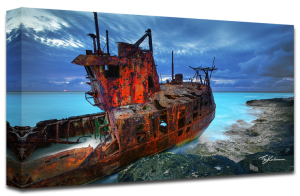This is a very common question we get asked and is one that goes without saying is almost as important as the work done in creating the artwork or photograph. The print is the final showpiece of the work and must reflect all the intricacies and nuances the artist or photographer and be a further extension of the creative process. Below are some advantages and disadvantages of both prints on paper, and prints on canvas so you can make the best decision possible when reproducing your work;
Prints on Paper
Printing on paper is the time-tested and traditional way of displaying a photograph. A photograph on paper has certain expected aesthetics and is a medium understood and appreciated by many. Traditional-medium artwork such as paintings have found success with paper prints, though it has generally been limited to posters and pre-framed prints. When the paper is matted and framed a dramatic effect can be achieved and the historical success of paper prints such as these speak to this point.
Advantages of Paper
- Traditional look and feel of photo
- More detail can be achieved for photographs when printed
- Frames add a decorative accent that can be matched to current decor
- Black and white prints are stunning on high quality paper
Disadvantages of Paper
- Images do not fill the size of the paper; generally there is a 3-5 inch border of blank paper around the image
- Prints will reflect sunlight and cause glare
- Traditional medium artwork (such as paintings on canvas) loses fine details and texturization seen in the original
- Frames can get expensive as the print size increases
Prints on Canvas
Gallery wrapped canvas prints offer a stylish, low-cost alternative to traditional framing. A gallery wrapped canvas giclée is a canvas print that has been stretched over stretcher bars so that the sides will either be a continuation of the image or a solid color. Digital photos printed on canvas and then gallery wrapped have a vibrant 3-D feel and have the look of a piece of work taken straight from a gallery or museum. Custom designed stretcher bars prevent compression marks and creases during handling and shipping. Sizes 24″x 30″ and larger should also have a brace bar support. Canvas prints also give the owner many framing options such as standard frames for non-stretched prints, custom-built standard frames for mounted, and floating frames which can give added aesthetics to the print.
Advantages of Canvas
- Large image size for given wall space; canvas does not have borders or mats
- Virtually unlimited sizing options with many panoramics reaching lengths of 80 inches or more
- Gives the image a “painted” effect
- Can be split into multiple panels for added visual effect
- Weighs much less than framed paper prints
- Can be hung in humid areas of the home or office such as the bathroom

Disadvantages of Canvas
- The texture of canvas must be considered along with the image being printed; it can be distracting to original image
- You cannot change the image like a paper print inside of a frame; once stretched and mounted it is permanent.
When choosing a medium for your prints it all depends on your tastes, preferences, and aesthetic needs.
Owning a canvas as a decorative piece means that you get more options of positioning, size and panel options. A canvas giclee print’s benefit of not producing glare, painted textures and vibrant colors look beautiful. However, a framed print has a classical look in itself also, and can work with almost any interior décor depending on the frame choice. Any high quality printer will help you in determining the best format and medium for your print and should provide you with a list of options and possibilities for your specific needs.

